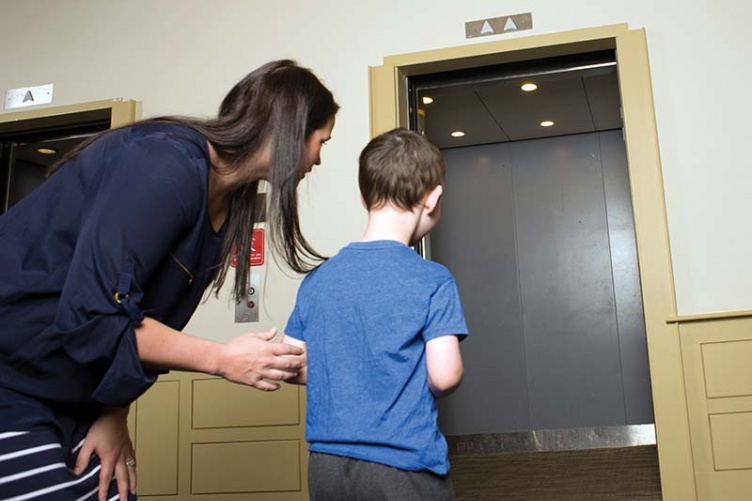
Photo by Valerie Lester
The family came to Outside the Lines, the pediatric occupational therapy practice started by Taylor Prendergast Moore ’07, ‘08G, seeking assistance. Their young son struggled with multiple disabilities, including anxiety and a profound lack of ability to understand where his body was in space.
Moore and her team had been working the problem in the office and were making progress, but one day the boy’s worried mother announced that an impending doctor’s visit in Boston would require riding an elevator, an experience the child couldn’t handle, physically or emotionally. “We were treating these issues in the office, but UNH taught us to be better than that, to treat not only the child’s disabilities, but also to address the whole family and environmental struggles in real time,” Moore says. “So off to the elevators we went!”
By the end of one session, Moore had the boy happily riding up and down elevators. A subsequent field trip to a new set of elevators confirmed that the problem had been resolved, and the family headed off to Boston with confidence. One week later they returned with a son who couldn’t wait to tell me all about his ride in ‘the big doctor elevators,’” Moore recalls with delight. It’s situations like this, she says, that continually remind her not to become stagnant in her therapeutic approach, but to instead place herself in the world her patients struggle with every day. “As occupational therapists, we use many research-based strategies and clinical theories to guide our interventions. We take these research-proven interventions and apply them in a child’s school, home or community, creating opportunities for a child's occupations of life to expand and grow across all environments—not just within the four walls of our clinic.”

A Long Way from Papier-Mâché
Occupational therapy has changed a great deal since the discipline was first formalized in 1917 under the auspices of the National Society for the Promotion of Occupational Therapy. In the early years, practitioners focused on “curative occupations” for “invalids and convalescents,” working in partnership with other rehabilitation agencies. In 1921, the group became the American Occupational Therapy Association (AOTA), and by 1923 the first accreditation efforts for OT educational programs were under way.
Nearly a century later, the profession is enjoying greater popularity and a more diverse client base than was likely ever envisioned by early practitioners. According to the AOTA, occupational therapy consistently ranks among the best jobs in health care and
also among the most recession-proof. And with the new emphasis placed on primary care by the Affordable Care Act, occupational therapists are increasingly sought after as members of multidisciplinary community-based teams focusing on health promotion, illness prevention and management of chronic physical and mental health disorders.
And while traditional medical and school settings remain a popular place of employment for occupational therapists, non-traditional settings — public spaces, private homes, facilities dedicated to treating brain injuries or homeless shelters where residents are trying to learn what constitutes healthy living — are becoming equally prevalent. “Occupational therapists land everywhere,” observes associate professor of occupational therapy Barbara Prudhomme White, who also serves as executive director of undergraduate programs at UNH. “We’re interested in helping people from anywhere and at any stage in their lives do the things that mean something to them. If you’re interested in functional performance and why people do what they do, OT is a great profession.”

UNH’s occupational therapy program turns 70 this year, and much has changed since students like Priscilla Garran Bergethon ’45 developed their skills by creating ceramic pots and papier-mâché puppets under the tutelage of famed New Hampshire artists Ed and Mary Scheier as members of the inaugural class. Established to meet the care demands created by World War II, UNH’s program (like many others) emphasized “diversional activities” aimed at distracting patients’ “mind(s) from thoughts of illness and invalidism”; the program’s first graduating class of eight — all women, selected for their “judgment, dependability, tact, tolerance, patience, kindness and high degree of physical and mental health” — supplemented their scientific coursework with classes in hygiene and sanitation, home management, handcrafts, carving, ceramics, puppetry, floriculture, woodwork and clothing construction.
It wasn’t until the mid-to-late 1960s that a real level of clinical and medical rigor took precedence over “practical” skills; the shift from traditional to more community-based settings is even more recent. These days, UNH students can be found anywhere from the slopes of Loon Mountain, assisting participants in the New England Disabled Sports program, to a halfway house, helping former jail inmates negotiate the practicalities of their post-release life. “Occupational therapy is often described as ‘curing by doing,’” says Prudhomme White. While you might find one OT working with a patient with a brain injury to regain basic motor skills in a clinical environment, you might as easily find another working with the same patient in a real-life setting, helping him relearn how to take a bus, create a budget or negotiate a job interview.
Out of the Box
UNH academic fieldwork coordinator Susan Merrill says the move away from traditional practice settings has been particularly pronounced during the past three to five years. To meet student and industry needs, the program is constantly seeking new avenues for training graduates. Clinical assistant professor John Wilcox, for example, oversees ‘Level 1’ OT fieldwork initiatives in seven different community settings that prepare students to lead everything from a post-concussion syndrome support group and fall prevention programs to a creative expression group at an independent livingcenter. Fieldwork opportunities, Wilcox says, bridge the gap between classroom theory and lectures and real services in
a community setting.
“Experiential, hands-on learning is critical to success as an occupational therapist,” he explains. “It’s essential that our students learn how to build rapport with clients.” Prudhomme White says it’s this ability to meet clients where they are that makes occupational therapists so marketable. “When you look at this profession from a 10,000-foot view, you realize that OTs can work in virtually
any setting.”

Chris Dunstan ’00 takes the concept of working in any setting quite literally. After graduation, Dunstan worked in a variety of traditional OT environments, but after several years of working with children, he knew he wanted to focus on students with developmental and functional needs outside the typical school setting. In 2011, he founded Dunstan Pediatric Services and began delivering customized care out of a 34’, Class-A motor home that has been transformed into a unique mobile gym and clinic to travel to schools and private homes in central New Hampshire. “Few of the schools we served had the luxury of dedicated space for occupational therapy,” he explains. “We often found ourselves delivering treatment in inappropriate rooms — libraries with no privacy or offices with no ‘kid-sized’ furnishings — so we decided to bring our treatment facilities with us.” Now, Dunstan says, his fully equipped, self-contained mobile space and team of 10 therapists provides services to more than 25 programs across the state.
In 2007, new certification requirements stipulated that occupational therapists have either a master’s or professional doctoral degree to go into practice, and UNH expanded its OT program to allow qualified students to earn both degrees in 5½ years of uninterrupted study. Academic fieldwork coordinator Merrill is responsible for helping UNH’s OT graduate students find the two 12-week ‘Level 2’ internships their master’s degree requires, with placements that range from New Hampshire’s White Mountains to Central America. Since 2010, five students have completed maternal and child health and geriatric public health internships through the National Association for the Practice of Anthropology OT Field School in Guatemala, and another student has gone to Nicaragua to work with impoverished elderly through the OT fieldwork branch of the Jesse F. Richardson Foundation. Earlier this year, five grad students made up the inaugural class of interns at New England Disabled Sports at Lincoln, New Hampshire’s Loon Mountain, working with both children and adults with a range of physical and cognitive disabilities, the first fieldwork placement of its type anywhere, Merrill says.
“It was out of the box, not quite as clinical as I would get in a hospital or a school,” says Loon intern Kailee Collins ’14, ’15G. “But we were still evaluating, treating, using so many different pieces of adaptive equipment. It drew all my clinical experience and all my school experience into one.”
Another new frontier for the profession: post-graduate residencies like the one Amy Ma ’12, ’13G is completing at the University of Chicago Medical Center. Chicago is currently the only accredited acute care residency program in the country, and Ma is one of the first three OTs to participate in it (one of the other two, Chelsea Steinberg ’11, ’12G, is also a UNH OT grad.) “My education at UNH gave me a strong occupation-based foundation for the residency,” Ma says. “I came into this program with a very good understanding of the unique ways in which occupational therapists can help patients.”

No Cookie Cutters Allowed
Back in Seacoast New Hampshire, Taylor Prendergast Moore is putting her own spin on the unique ways occupational therapists can help patients. Following graduation, Moore began her career working in a pediatric facility attached to a hospital, but soon stepped out on her own. “All through school, I dreamed of owning a private practice working with pediatric patients,” Moore says, “and after a few years of working in a conventional setting and constantly wrestling with the feeling that I could be doing more for my patients, I decided to take the plunge and open my own practice.”
With a vision of helping children struggling with disabilities or processing deficits realize their full potential, Moore founded Outside the Lines in 2012. She credits the university’s OT department for developing her ability not only to see the pathway to a better way of helping these children and their families, but also to establish a viable practice model for achieving her goals.
“UNH trained me to perform a clear-eyed assessment of a population’s needs and to avoid becoming stagnant in my treatment approach,” Moore says. “We’re taught to do solid, evidence-based research and develop methodologies tailored to the specific population we’re treating. I was trained not to be a cookie-cutter therapist, and I take that dictate very seriously.”
Moore’s approach is clearly resonating with both referrers and clients. Her Dover practice today employs a team of seven, including two of Moore’s fellow UNH grads. Outside the Lines has moved to increasingly larger spaces twice since opening its doors, and is preparing to move again in the coming months. Moore also has started bringing high school students and current UNH undergrads with an interest in OT into the practice for internships. “I feel like I have an obligation to give back to my community, and I had great fieldwork experiences when I was in college, so I’m happy to give others the opportunity to explore the field,” she says.
“I love what I do,” she adds. “I think the OT department would be proud to see us remembering and applying the valuable lessons we learned at UNH.”~
Lori L. Ferguson is a freelance writer based in southern New Hampshire. She enjoys writing on lifestyle, health & wellness topics as well as all things artistic. www.writerloriferguson.com
Originally published in UNH Magazine—Spring/Summer 2015 Issue
-
Written By:
Lori Ferguson | Communications and Public Affairs



















































